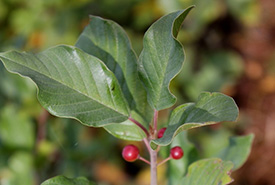
Glossy buckthorn (photo by Calin Darabus)
Glossy buckthorn
Glossy buckthorn is a non-native tree that was introduced to Canada from Eurasia approximately 100 years ago. It can grow as tall as seven metres. Once used for landscaping, this tree has now become an invasive species.
This species produces leaves early in the spring and keeps its leaves late into the fall. The dense thickets outcompete native vegetation.
How is it identified?
When glossy buckthorn is young, it often has multiple stems. As it matures, the stems merge into a tree trunk that can be up to 20 centimetres in diameter. The leaves are 1-3 centimetres long. Its leaves are oval shaped and slightly wavy, shiny on top and hairy underneath.
The stems are a greenish colour, and the bark on older branches is grey-brown, speckled with white dots. The sapwood under the bark is yellow, and the heartwood at the centre of the plant is pink to orange.
It produces greenish white flowers with five petals from late May to early September.
How does it grow?
Berries are produced from July to September. They are about the size of a pea, and as they ripen, the colour changes from green to red to a dark purple. Birds eat the berries and disperse the seeds inside.
Where does it grow?
Glossy buckthorn's range extends from western Manitoba to eastern Nova Scotia, and as far south as Minnesota, Illinois, New Jersey and Tennessee. It grows in sunny, moist sites, in both wetlands and woodlands.
What is NCC doing to control this species?
At the Pugwash River Estuary in Nova Scotia, NCC staff, volunteers and the Friends of the Pugwash Estuary have focused their efforts into eradicating this species. In June 2014, approximately 5,000 stems of glossy buckthorn were removed in the area.
How can you help?
Early detection is important in managing non-native invasive species. When the seedlings are small they can be pulled, especially when the ground is soft. When doing so, it is important to get as much of the root as it possible. Larger saplings and small trees can be cut, but doing so will not kill the plant as the stems will resprout vigorously so herbicide should be applied to cut stems. In heavily invaded sites, repeated effort is usually required over several years.
Everyone can help to win the battle against alien invasive species. Here are some ways you can help:
- Dispose of yard waste properly. Dumping yard waste in natural areas can introduce alien invasive species that will thrive and spread. Even leaf piles can be problematic, as dumped piles can smother native vegetation. Contact your municipality to find out how to dispose of yard waste properly.
- Plant native species in your garden! There are lots of beautiful native species that attract native butterflies and birds, making your garden twice as beautiful. Native species are also adapted to our climate and often require less rigorous care than exotic species.
- Report sightings of invasive plants to your local stewardship council. Finding these invasions early is key to eradicating them.
- Clean your shoes or bicycle tires when moving from designated trails in different areas. Invasive plants are often spread accidentally from seeds stuck in treads.




